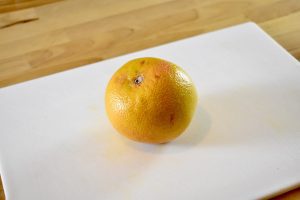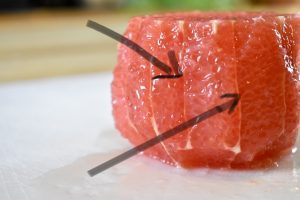How to Segment Citrus

Follow this guide to skillfully remove segments of citrus without any pith or skin attached.
These gem-like pieces are perfect for an elevated dish you are working on, a citrus salad, a beautiful dessert, or just as a snack.
- Prep Time10 min
- Special Equipment
- Sharp knife
- Any citrus:
- clementine
- lime
- mandarine
- tangerine
- lemon
- orange
- grapefruit
- pomelo

Start with your citrus of choice, a grapefruit in this instance, a sharp knife (I use a large chef’s knife, but a smaller knife, even a paring knife, is fine as long as it’s sharp), and a cutting board.

Turn the citrus onto its side so that the stem and blossom ends (the “eyes”) are facing to the sides.

Make your first cut near the side of the citrus. On smaller citrus like clementines and limes you’ll be able to cut closer to the edge, but large citrus like grapefruits have more white pith between the skin and the flesh. You’ll come to get a feel for this the more citrus you segment.

Now repeat on the other side. You want to expose a fair amount of flesh. Don’t be afraid of wastage, you’ll squeeze the scraps for juice later.

Turn the citrus over so that a cut side is down on the cutting board.
Put your knife where the white pith meets the flesh on top of the citrus and cut down to the cutting board.

As you get better at this, you can begin to follow the round contours of the citrus, using a slight sawing motion, in order to cut out less flesh.

Now repeat this cutting action around the entire citrus.

Don’t worry about any white parts leftover yet.


As you can see, there will probably be a fair amount of white pith left on the citrus, particularly near the bottom.

Use your knife to carefully trim off any white pith you can find on the exterior of the citrus. This is where having a sharp knife is very important.

Now take a close look at your trimmed citrus. You’ll notice a thin wall or membrane separating each segment of flesh.

Take your knife and cut along the inside of one of those walls, staying as close to it as possible.

You want to cut until you feel resistance which should be near the centre of the citrus. Don’t cut all of the way through, just until you meet that resistance.
Now remove the knife and cut down the inside of the other wall.

Again, gently cut to the centre, where you’ll meet some resistance.

You’ll notice that the walls separating the segments form a bit of a ‘V’.
You may need to shimmy the knife around at the bottom of that ‘V’ to fully detach the segment.
Once you feel it loosen, gently draw it out with the knife.

Now repeat with the rest of the segments, moving on to the inside of the next wall.

Continue until you’ve removed all of the segments. They’re not always even, some will be larger or smaller than others.

Be careful with the knife as you near the end, since the citrus will be less stable.

Once you’ve removed all of the segments, you’re left with the interior wall structure of the citrus, as well as the peels which may have juicy flesh still attached. If you’re using the citrus segments in a salad, I like to squeeze all of leftover bits and add the juice to the dressing. Otherwise I squeeze it right into a glass and drink it up!

The segments are now ready. Try them in a salad with honey, the squeezed citrus juice, and fresh mint, or as part of a beautiful dessert. The more you do this, the easier it will be, so keep practising!





